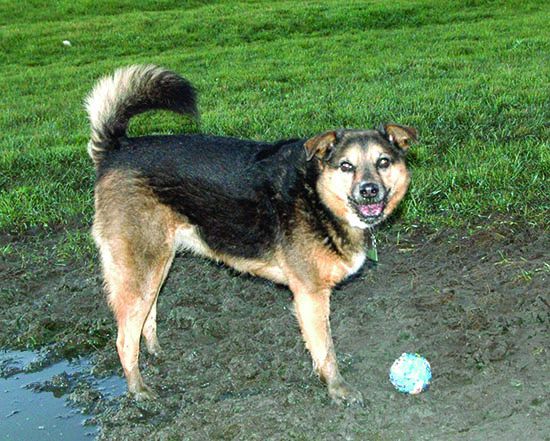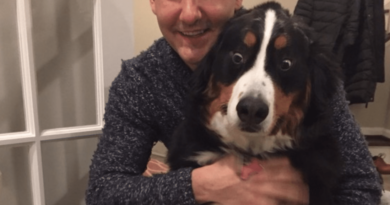Dog Tail Meaning | Dog Tail Language
Everybody knows that when a dog approaches you wagging her tail it means she’s inviting you to pet her, right? Wrong! We may have all grown up thinking a wagging tail means a happy dog, but that misconception has gotten countless well-intentioned dog-lovers bitten, sometimes quite badly.
So here’s the thing: A wagging tail does not necessarily mean a happy dog. It simply means arousal of some kind. That can be happy arousal, or fear, excitement, or even aggressive arousal. Here are some tips to help you decipher the canine tail-wagging lexicon:
DOG TAIL MEANINGS

Tail wagging works well for dogs in the canine world. Since dogs communicate primarily through vision and body language, dogs are generally very good at understanding each other’s tail wags. (And yes, dogs who are born with short tails or whose tails are docked are at a very significant disadvantage when it comes to tail talk!)
In general, the higher the dog’s tail and faster the wag, the greater the level of arousal. While a very high tail indicates high arousal, a very low-wagging tail most often denotes fear and appeasement.
High tail wag. A “flagging” tail – straight up or even curved slightly over the dog’s back – moving at blur-fast speed, is an indication of strong emotion. Of course, some dogs naturally carry their tails straight up or curled over their backs (Huskies, Pomeranians, Pugs, Basenjis, and more), so you need to take that into consideration when tail-reading.

But how do you know if it’s a fun-and-games, fast-wagging high tail saying, “I’m so happy and excited to see you! Yes, please pet me!” or an aroused and angry high tail telling you, “If you try to pet me, you’ll be toast!”?
The simple answer: body language. The “Pet me!” dog is animated and wiggly, with soft or squinty eyes and an inviting open-mouth grin. Sometimes her whole body wags!
In contrast, the “I want to eat you!” dog is likely to have a tense body and hard eyes, with all his energy focused forward – no wiggling. Even still, a happy aroused dog can do damage in her excitement, so you are better off waiting to engage even with a happy high-tail wagger until she calms down a bit.
Meanwhile, a high-but-slower tail wag suggests less active arousal, but it still can be a caution sign. She may just be happy and not as aroused, or it might be that an elevated level of tension has slowed the aggressive dog’s tail; it could be the beginning of an agonistic freeze just before the bite happens. (“Agonistic” refers to a continuum of social behaviors including all aspects of aggression, from appeasement and flight at one end, to warning signals, threat and actual attack at the other extreme.)
Again, reading the dog’s entire body language will help you determine what’s really going on, and if it might be safe to interact, or not.

Half-mast tail wag. A medium-height tail wag is generally an indication of a calmer, less aroused dog. The speed of the wag can further indicate how calm the dog might be.
I like to look for what I call “the half-mast swish,” where the tail is gently wafting back and forth at about hock level. A faster wag indicates more energy on the dog’s part (happy or angry energy), and a fast wag that slows to a freeze is always a warning sign.
A dog with a half-mast wag can still bite you. Watch all the body language, not just the tail. Happy, relaxed tail wagging is usually accompanied by a happy facial expression. A happy dog usually has bright eyes, a relaxed open mouth, and possibly a gentle pant.
Circle tail wag. This is my favorite, and the most unambiguous of all the tail wags. Most often, a dog will wag her tail in a circle if she is particularly overjoyed to see someone special, especially someone she hasn’t seen recently. A very friendly dog may offer this wag in happy excitement any time she meets someone she wants to call her friend, even someone new to her.
Although I’m sure there might be exceptions, I have personally never seen a dog do a circle wag who had any aggressive intent.
Low tail wag. When the wagging tail goes below half-mast, the dog is likely feeling fearful and defensive. The lower the tail wag, the stronger the emotion. The low tail wag is often accompanied by a lowered body posture and, sometimes, submissive urination. Also, the faster that lowered tail is wagging, the more emotion the dog is expressing to you.
It may be tempting to try to comfort the low-tail wagger. Don’t! All that appeasement behavior she’s offering is her way of telling you that you are making her very uncomfortable and she wants you to leave her alone. She may even roll over on her back as she wags her tail.
Sadly, this appeasement behavior is often misinterpreted as an invitation for a belly rub. Again, don’t. While some dogs may enjoy a belly rub, a low-tail wagger is likely pleading with you to go away; she feels very threatened by your proximity and is making a last-ditch effort to get you to leave her alone. Rubbing this dog’s belly is quite likely to result in a significant bite, often to the face of the person doing the rubbing, since you are probably bent over her for the rub.

Absence of wagging. The lack of tail movement can also give you information – again, in context with the rest of the dog’s body language.
If a dog is calm and relaxed, a motionless tail just means that the dog is being zen – not enough emotion happening to make the tail move. A fearful dog whose tail is still is likely shut down, afraid to move at all. An aroused, angry dog whose tail stops wagging may be doing the agonistic freeze mentioned above. And a happy aroused dog may be engaging in a whole-body “pause” prior to a play bow, a bounce, or some other play-invitation behavior.
Left Side Wags vs. Right Side Wags
Canine “tail talk” is so complex that even the direction of the wagging is significant. Studies suggest that dogs more frequently wag their tails to the right when they are happy or confident and to the left when they are fearful. There appears to be a scientific reason for this.
The left side of the brain controls movement on the right side of the body and vice versa, which means the left brain is engaged when the tail wags to the right and the right brain causes the tail to move to the left. Since the left side of the brain is associated with positive feelings, a happy dog is likely to wag her tail to the right. Conversely, the right half of the brain is associated with negative feelings, so a fearful dog is likely to wag her tail to the left.
DOG TAIL LANGUAGE DURING DOG-DOG INTERACTIONS
The same interpretations hold true for dog-dog meet and greets. A high, fast tail wag indicates a significant amount of arousal; use caution with this introduction. Do parallel walking until the tails slow down and you can determine if the wagging is from happy excitement wagging or tension that could lead to a fight.

Hock-level wags are more promising, and a circle wag is ideal. A low-tail wag during dog introductions tells you that the dog is unsure, perhaps feeling threatened. If the more assertive dog responds appropriately to this by slowing down and toning down his energy level, all may go well.
If, instead, he continues an energetic, assertive approach, the dog offering appeasement signals may become defensively aggressive and a fight can ensue. Often the more appeasing dog gets blamed for this fight when, in fact, it’s the fault of the more assertive dog for not responding appropriately to the other dog’s signals!
It’s imperative that you intervene before a fight happens when you see that an energetic assertive dog is not honoring the message sent by a low-wagging tail. Again, parallel walking and controlled interactions may serve to salvage this relationship.

TAKE IN THE WHOLE DOG’S BODY LANGUAGE
Regardless of the tail-wagging message, you are safest when you let the dog approach you and initiate the interaction. Reaching out to pet a dog, even one with a soft half-mast swish, could trigger a defensive response. Let the dog come to you.
And regardless of whichever side a dog’s tail is wagging on, the more you pay attention to the whole dog, the better you’ll be able to understand what that wagging tail is really trying to communicate. Our dogs are talking to us all the time. Remember to listen with your eyes.





